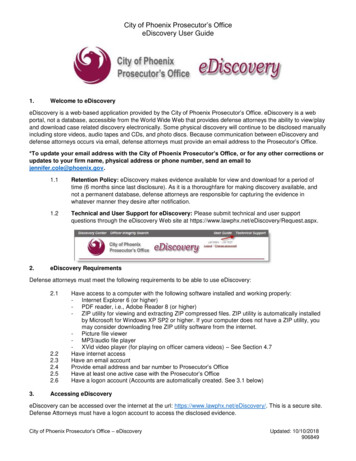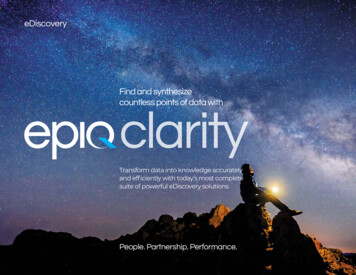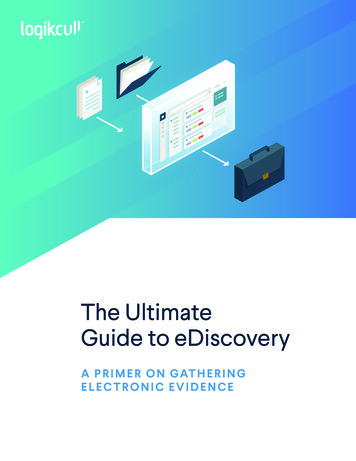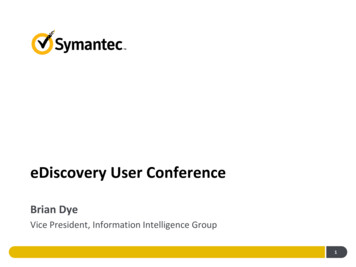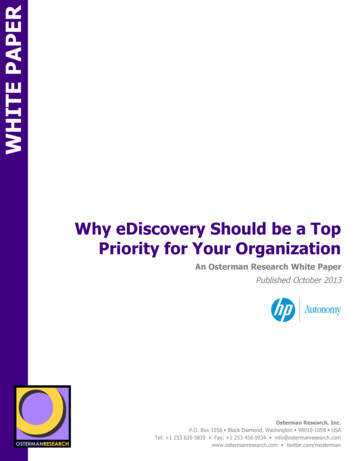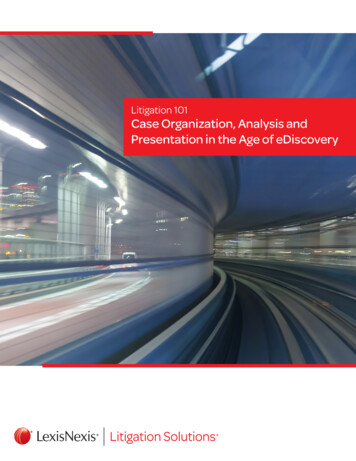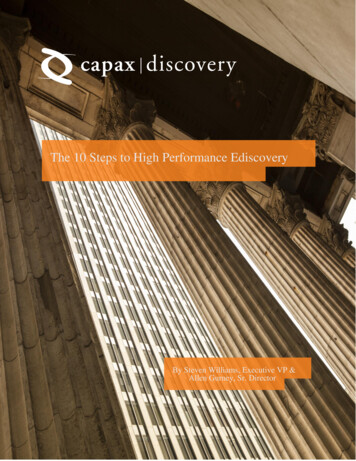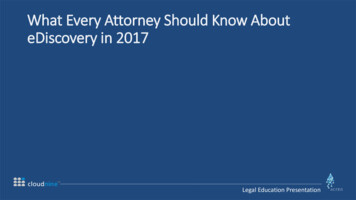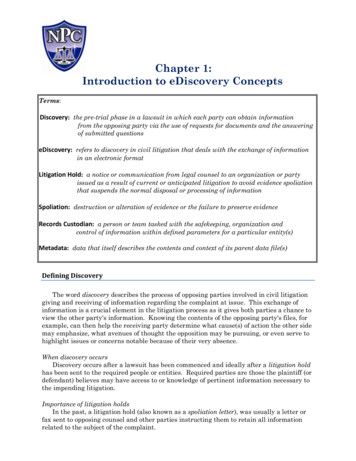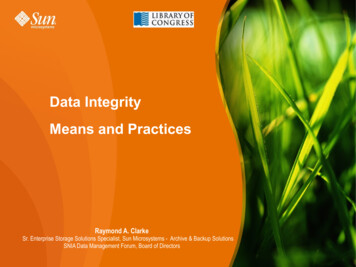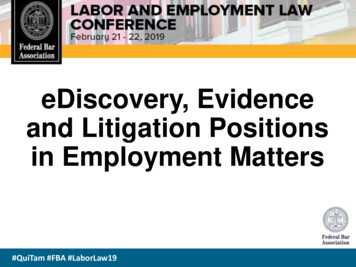
Transcription
eDiscovery, Evidenceand Litigation Positionsin Employment Matters#QuiTam #FBA #LaborLaw19
Agenda Brief Intro to eDiscovery eDiscovery Challenges in Employment Litigation Proportionality, Cost-Shifting, Cooperation and Preservation inthe employment context Unique Considerations by Matter Type Bring Your Own Device Considerations Litigation Support Tools and TAR Trends and Predictions Q&A#FBA #LaborLaw19
#FBA #LaborLaw19
eDiscovery Rules in a NutshellFRCP Rules 1, 16, 26, 33, 34, 37 & 45 Collaboration/cooperation Scope of Search and Production‒ ESI subject to discovery‒ “Proportionality Rule” Production & Data Sampling‒ Form of production Inadvertent disclosure of privileged ESI Sanctions for Spoliation#FBA #LaborLaw19
Rule 1. Scope and Purpose– Extends to parties the obligation to construe rules to achieve the just, speedyand inexpensive resolution of actions. Rule 16. Pretrial Conferences; Scheduling; Management– Scheduling orders may address preservation obligation and Fed. Evid. 502Agreements Rule 26. Duty to Disclose; General Provisions Governing Discovery– Permits discovery of ESI relevant to party’s claim or defense– Proportional to the needs of the case– Two-tiered framework of discoverable data Accessible vs. Not reasonably accessible Rule 33. Interrogatories to Parties#FBA #LaborLaw19
Rule 34. Producing Documents, ESI and Tangible Things Rule 37. Failure to Make Disclosures or to Cooperate in Discovery;Sanctions– Grants courts the authority to sanction parties for the failure to preserve ESI– Resolves circuit split concerning the severity of sanctions– Only governs the spoliation of ESI; does not restrict court’s “inherentauthority”– Does not preempt stand alone tort claims for negligent/intentional spoliationunder state grounds Rule 45. Subpoena– Mimics 26(b)(2)(B), 34(b)(2)(E) and 26(b)(5)(B) Accessibility Tier Form/Methodology of Production Claims of Privilege#FBA #LaborLaw19
eDiscovery Challenges in Employment Litigation Costs/burdens relative to value of claim– Universe of discoverable material increased exponentially in the workplace– Increased relevance of ESI in fact intensive employment disputes (e.g.discrimination, harassment, retaliation, wage & hour)– Incentivized early settlements regardless of merit? – e.g. Title VII 300k limit Asymmetrical/data imbalance– Employer typically maintains possession, custody and control of majority ofdiscoverable ESI– Reduced incentive on employee’s part to cooperate? Employees typically have limited discoverable ESI Generally spend less time and resources responding to RFPs#FBA #LaborLaw19
eDiscovery Challenges in Employment Litigation Confidentiality of E-mails: Employer’s E-mail System vs. Webbased email– Courts split on waiver issue Scott v. Beth Israel Medical Ctr., 17 Misc.3d 934, 937-938 (Sup. Ct. N.Y.Co. 2007)(use of employer’s email system deemed waiver of privilege) Steingart v. Loving Care Agency, Inc., 201 N.J. 300 (2010)(upholdingexpectation of privacy/confidentiality over web-based emails regardlessof company policy advising otherwise) Kreuze v. VCA Animal Hospital, Inc., No. PJM-17-1169, 2018 WL1898248 (D. Md. Apr. 20, 2018) (plaintiff’s use of her work e-mail accountto send attorney-client communications not waiver of the attorney-clientprivilege)– Subject to applicable rules of professional conduct#FBA #LaborLaw19
eDiscovery Challenges in Employment Litigation Social Networking Communications– Actionable vs. Protected– Policies restricting employee comments about work conditions; termsand conditions of employment– Following Employees– Using Social Media in the Vetting Process– Responding to complaints made through social media Differing guidelines on Preservation/Disposition of employeedocuments and data#FBA #LaborLaw19
Proportionality Can be basis to challenge overly broad/burdensome discovery– Vaigasi v. Solow Mgmt. Corp., 2016 WL 616386, at *13 (S.D.N.Y. Feb. 16, 2016) Showing of nature and quantity of undue burden required by employers– Rule 26 (b)(1)– Fish v. Kobach, 2016 WL 893787, at *1 (D. Kan. March 8, 2016)– Zoobuh, Inc. v. Better Broadcasting, LLC, 2017 WL 1476135, at *4-5 (D. UtahApr. 24, 2017) Stronger argument for compelling production where employer sole sourceof information:– Albritton v. CVS Caremark Corp., 2016 WL 3580790, at *4 (W.D. Ky. June 28,2016) Can also be basis to limit employer’s ability to seek discovery?– Williams v. U.S. Environmental Services LLC, 2016 WL 684607, at*3(M.D. La. Feb. 18, 2016)#FBA #LaborLaw19
Cost Shifting Remains the exception, not the rule- Court authority added to Rule 26(c)(1)(B) as part of 2015amendments Allows courts to protect parties from undue burden or expense- As per Zubulake I, 217 F.R.D. 309 (S.D.N.Y. 2003), many courts onlydeem it available whenever ESI is considered “inaccessible” Seven factor test developed by Zubulake I, continues to be appliedby courts following the 2015 amendments No discussion about whether amendments affect applicability of 7factor test- Bailey v. Brookdale Univ. Hosp. Med. Ctr., 2017 WL 2616957(E.D.N.Y. June 16, 2017)#FBA #LaborLaw19
Duty to “Cooperate” Embedded within legislative intent of Rule 1 as amended on 2015‒ Not expressly incorporated so as not to create a new or independent sourceof sanctions; basis for discovery motions Intended purpose of good faith cooperative exchange about the existenceand accessibility of ESI‒ Transparency encourages parties to work together towards resolution#FBA #LaborLaw19
Duty to “Cooperate” Courts increasingly overseeing and enforcing parties’cooperation responsibilities– Aside from Fed. R. Civ. P. 1 2015 amendments, the Federal Rules ofCivil Procedure imply cooperation Fed. R. Civ. P. 16 – Pretrial ConferencesFed. R. Civ. P. 26(a)(1) – Initial DisclosuresFed. R. Civ. P. 26(b)(2)(C) – Discovery Scope and LimitsFed. R. Civ. P. 26(f) – Meet and ConferFed. R. Civ. P. 26(g) – Signing Disclosures and Discovery Requests– Historically had not been used enough to promote cooperation? Hon. David J. Waxse, Cooperation: What is It and Why Do It? 18Rich. J.L. & Tech. 8 (2012)#FBA #LaborLaw19
Duty to “Cooperate” Increasing need/obligation to treat the meet and conferprocess seriously– Failure to do so can damage interests and credibility in subsequentdiscovery disputes– See, e.g., Bailey v. Brookdale Univ. Hosp. Med. Ctr., 2017 U.S.Dist. LEXIS 93093, at *14–17 (E.D.N.Y. June 16, 2017) (refusingto allow plaintiff’s attorney in employment litigation to rescinddiscovery agreement despite substantial cost of eDiscoveryinadvertently agreed to)#FBA #LaborLaw19
Preservation in General Preservation starts with data governance– Outside employment counsel uniquely situated to advise– Develop policies and procedures related to communications (email, chat,social media) data management, retention– Map/understand systems that are repeatedly needed for litigation Duty arises once a party reasonably anticipates litigation– 2015 amendments chose not to expressly address when duty to preserve istriggered Preservation/litigation hold process in place Content of litigation hold notice (e.g. nature of litigation, criteria fordetermining info. to be preserved, steps to be taken. etc.)#FBA #LaborLaw19
Employer vs. Employee Preservation ObligationsEmployer considerations Duty may attach earlier than in other commercial litigation contexts(potential vs. reasonable anticipation)‒ Contentious termination of employment Snider v. Danfoss LLC, 2017 U.S. Dist. LEXIS 107591, at *13 (N.D. Ill.July 12, 2017) (obligation “obvious” in light of employee threat to sue).‒ Demand letter; Agency notice of investigation or charges See Goonewardena v. State Workers Comp. Bd., 258 F. Supp. 3d 326,348 (S.D.N.Y. 2017) (employee filing charge with U.S. EEOC))‒ Reductions in force‒ Internal complaints about violations of law or policies#FBA #LaborLaw19
Employer vs. Employee Preservation ObligationsEmployer considerations (cont’d) Number and makeup of possible custodians and others to be appraised ofduty to preserve‒ E.g. HR, managers, co-workers, IT, third-party service providers, PEOs,joint employers Volume and types of potentially relevant data to be preserved are subjectto type of claims/allegations‒ E.g. collective actions under FLSA#FBA #LaborLaw19
Employer vs. Employee Preservation Obligations Schmalz v. Village of North Riverside, No. 13-cv-8012, 2018 WL 1704109(N.D. Ill. Mar. 23, 2018)‒ Loss of 50 text messages led to sanctions under Rule 37(e) followingemployer’s admission of having received a legal hold notification and nottaking any steps to preserve the texts Franklin v. Howard Brown Health Center, 1:17-cv-8376 (N.D. Ill. Oct. 4,2018)‒ Flawed legal hold process in workplace harassment and discriminationclaim led to adverse inference instruction‒ Despite “instant messages” being main source of harassment,messages were not preserved#FBA #LaborLaw19
#FBA #LaborLaw19
Employer vs. Employee Preservation ObligationsEmployee considerations Likely less familiar concerning their discovery obligations Depending on claims, scope may include:––––Social media profiles; postings; status updatesText messagesElectronic calendar entriesOther device data (GPS, public hotspot “check ins”, fit data) Waters v. Union Pacific Railroad Co., No. 15-1287-EFM-KGG (D. Kan.June 21, 2016) (employee compelled to produce social media accountinformation as well as postings from dates he missed work in conjunctionwith injury claims)#FBA #LaborLaw19
#FBA #LaborLaw19
eDiscovery Considerations by Matter TypeEmployment Discrimination Plaintiff bears burden of proof compounded by costs of accessing andreviewing relevant ESI‒ Further heightened by reliance on circumstantial evidence Employer’s “greater access” to information deemed unfair advantage?#FBA #LaborLaw19
eDiscovery Considerations by Matter TypeEmployment Discrimination (cont’d) David A. Green, The Fallacy of Liberal Discovery: Litigation EmploymentDiscrimination Cases in the E-Discovery Age, 44 Cap. U.L. Rev. 693 (2016) Should the shift to proportional discovery recast employees’ burden ofproof which is arguably contingent in “liberal discovery”?; employer’sshowing of “real reason”?– Evidentiary standards set forth that party bringing a claim has the burden ofproof– Proportionality/cooperation should play crucial role in facilitating ruling on themerits– Employer still bears burden of paying costs of review/production of ESI#FBA #LaborLaw19
eDiscovery Considerations by Matter TypeWage & Hour Litigation Broader scope of potential evidence requires expansion of search touncommon sources of data Repurposing of data so that it may be used in ways not meant to be used No ready source to construct amount of time/liability concerning workperformed by contractors or exempt employees– E.g. date and time-stamp of activities/business/computer transactionstied to specific employees; network and computer logs; electronicbadge swipes; GPS on service vehicles#FBA #LaborLaw19
DATA FROM MANY DIFFERENT SOURCESWindowsInformation Technology (VPN)Operations (Dispatch)Fleet Management (GPS)Finance (Invoices)Personal (Detours)Human Resources (Time Card)#FBA #LaborLaw19
POWERFUL INSIGHT TO CLAIMS AND DEFENSESLogin 10 min1After GPS234After 1st Invoice14151617Free Time18Padded TimeHome Invoice56789Late Punch-In10Late Punch Out13Personal DetourDriving Distracted11No After Hours#FBA #LaborLaw1912
REPORTEDDAY43765216#FBA #LaborLaw1978910111212349:30
ACTUALDAY4? 243 Times in 6 months?37652?16#FBA #LaborLaw1971,2839104,51112162345:453:45
eDiscovery Considerations by Matter TypeInvestigations No obligation to review voluminous amounts of content; justget to the answer. Forensic investigation can uncover user activity on andacross devices (e.g., theft of trade secrets) Powerful analytic tools use artificial intelligence to honein on “hot documents”#FBA #LaborLaw19
BYOD and eDiscovery Greater Risks in BYOD environments?– Mobility Device Management– Mobile Application Management Employers’ eDiscovery obligations are more limited when personaldevices are not used for work-related purposes– Discouragement for the design/implementation of BYOD policies? BYOD devices should form part of early preservation assessment– Small v. University Medical Center of South Nevada, 2018 WL 3795238,at *63 (D. Nev. Aug. 9, 2018)(sanctioning employer for failure toaddress BYOD devices as part of litigation hold)#FBA #LaborLaw19
Discovery – Paradigm Shift Traditional approaches to searching for evidence no longerpractical and/or financially feasible Challenge of identifying and producing responsive ESI on time,within budget, without waiving privilege Complying with certification requirement– That “to the best of [his/her] knowledge, formed after a reasonableinquiry ” the response is “complete and correct” Fed. R. Civ. P. 26(g)(1)(A) 31 L.P.R.A. Ap. V, R. 9.1/Vellon v. Squibb Mfg., Inc., 117 D.P.R. 838,n.17 (1986)#FBA #LaborLaw19
Discovery – Paradigm ShiftSearch and Retrieval Challenges Synonymy‒ Variety of ways to say samething Polysemy‒ Different meanings in contexts Jargon and acronyms‒ Employer’s own use of wordsand/or expressions Confirmation bias‒ Searching for information thatproves party’s theory; rather thanevidence that tests whether partyis correct‒ Focus should be directedtowards information that teststheories Challenge in “identifying” rightwords‒ Difficulty in isolating all relevantreferences#FBA #LaborLaw19
Litigation Support Tools Ensure proper identification and preservation of ESI Facilitate search, review and production Generally involves partnering with an electronic discoveryvendor/consultant to assist in the identification, collection,processing, analysis of data#FBA #LaborLaw19
Litigation Support ToolsIntended functions to assist attorneys in organizing andreviewing ESI: Processing– Extraction and conversion ofdata from files– Deduplication Document repositorySearch and retrievalDocument controlClassification#FBA #LaborLaw19 IndexingSortingBates StampingRedactionIn-court presentationfunctions Compare modules
Litigation Support ToolsTechnology Assisted Review (“TAR”) Method of document review where attorneys’ review decisions aresubmitted to a computer algorithm that finds conceptually similardocuments to ultimately predict relevance and other determinations. Acknowledged as a permissible form of document review– Da Silva Moore v. Publicis Groupe & MSL Grp., 287 F.R.D. 182, 192(S.D.N.Y. 2012) Proven to be more accurate/cost effective than exhaustive manual review Inconsistent ruling as to amount of disclosure required prior to warrantingits use#FBA #LaborLaw19
Litigation Support ToolsTechnology Assisted Review (“TAR”) Open-ended controversy concerning the requesting party’s evaluation ofthe adequacy of production– Courts lack judicial authority to order production of irrelevant documentswithheld from “seed set”– Does two-way effectiveness of TAR depend on parties’ transparency/foregoprivacy concerns? Whether parties may be compelled to use one technology over anotheralso remains a disputed issue– In re Bridgepoint Education Inc., Securities Litigation, 2014 WL 3867495 (S.D.Cal. 2014)– Hyles v. New York City, 2016 WL 4077114 (S.D.N.Y. 2016)#FBA #LaborLaw19
2019 Trends and Predictions Gradual modification of eDiscovery practices to incorporate personal dataprivacy protection‒ Meanwhile increased acceptance that “personal” data may be relevant tocommercial disputes Increased threat of data breaches of ESI platforms– Continued threat to law firms housing client data Increased acceptance and adoption of data analytics tools andTechnology Assisted Review (“TAR”) Increased role of corporate data other than communications#FBA #LaborLaw19
Q&A
Employers' eDiscovery obligations are more limited when personal devices are not used for work-related purposes -Discouragement for the design/implementation of BYOD policies? BYOD devices should form part of early preservation assessment -Small v. University Medical Center of South Nevada, 2018 WL 3795238,
